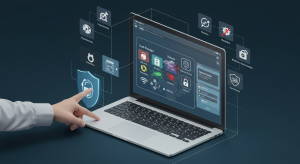SaaS (software as a service) Lifecycle Management refers to the methods used to manage and maintain a SaaS offering, from the prototype stage to the retirement stage, where the SaaS offering is no longer in service. SaaS Life Cycle Management calls for the use of agile management tools, due to the shorter time frames involved between releases, which includes upgrades, enhancements and bug fixes. SaaS Life Cycle Management can be facilitated through the use of a SaaS source code management application. SaaS source code management tools provide efficiency gains and cost savings to SaaS developers / ISV’s (independent software vendors) that on-premise source code management tools can not compete with.
SaaS source code management applications may be leveraged by SaaS project developers to manage all of the elements related to the various phases of the SaaS Development Lifecycle, including: business requirements, functional requirements, design requirements, security requirements, data requirements, performance requirements, contract requirements, service level agreement requirements, testing requirements (test cases) and defect tracking, etc. Full featured SaaS source code management applications are built upon SQL databases or repositories that may be queried in order to find out specific information about any element of a SaaS offering, providing the capacity to trace any element of an application from the definition stage to the deployment stage.
SaaS source code management applications also provide a flexible way to manage projects and disseminate information, with customizable reporting and messaging features including dashboards and email alerts that speed up collaboration between team members. A SaaS source code management application can simultaneously function as a content management system, a project management tool, a resource management tool and a workflow management tool; providing SaaS providers with a comprehensive solution for SaaS Lifecycle Management.
At the detailed level, SaaS source code management applications are highly configurable, providing SaaS ISV’s with the ability to customize the SaaS Life Cycle Management application to the needs of each SaaS offering being managed. For example, capabilities for defining domains, users, forms, database views, workflows, custom fields, email rules, etc. are commonplace in many of the SaaS source code management applications on the market today.
Apprenda’s SaaSGrid offering provides SaaS ISV’s with many tools for SaaS source code management. For example, SaaSGrid provides the ability to manage a SaaS offering through various phases of the SaaS Lifecycle including: the development phase, the test phase, the production phase and the post-production (archived) phase. What’s more, SaaSGrid provides the capacity to easily build update patches and upload new builds automatically using internally built test systems and also provides the tools to promote all changes into production seamlessly.
This page is an archive. To learn more about archive pages click here
The responses below are not provided, commissioned, reviewed, approved, or otherwise endorsed by any financial entity or advertiser. It is not the advertiser’s responsibility to ensure all posts and/or questions are answered.


